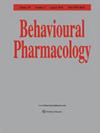Discriminative stimulus properties of Cannabis sativa terpenes in rats.
IF 1.6
4区 心理学
Q3 BEHAVIORAL SCIENCES
引用次数: 0
Abstract
Cannabis is a pharmacologically complex plant consisting of hundreds of potentially active compounds. One class of compounds present in cannabis that has received little attention are terpenes. Traditionally thought to impart aroma and flavor to cannabis, it has become increasingly recognized that terpenes might exert therapeutic effects themselves. Several recent reports have also indicated terpenes might behave as cannabinoid type 1 (CB1) receptor agonists. This study aimed to investigate whether several terpenes present in cannabis produce discriminative stimulus effects similar to or enhance the effects of Δ9-tetrahydrocannabinol (THC). Subsequent experiments explored other potential cannabimimetic effects of these terpenes. Rats were trained to discriminate THC from vehicle while responding under a fixed-ratio 10 schedule of food presentation. Substitution testing was performed with the CB receptor agonist JWH-018 and the terpenes linalool, limonene, γ-terpinene and α-humulene alone. Terpenes were also studied in combination with THC. Finally, THC and terpenes were tested in the tetrad assay to screen for CB1-receptor agonist-like effects. THC and JWH-018 dose-dependently produced responding on the THC-paired lever. When administered alone, none of the terpenes produced responding predominantly on the THC-paired lever. When administered in combination with THC, none of the terpenes enhanced the potency of THC, and in the case of α-humulene, decreased the potency of THC to produce responding on the THC-paired lever. While THC produced effects in all four tetrad components, none of the terpenes produced effects in all four components. Therefore, the terpenes examined in this report do not have effects consistent with CB1 receptor agonist properties in the brain.大麻萜烯对大鼠的辨别刺激特性。
大麻是一种药理复杂的植物,由数百种潜在的活性化合物组成。大麻中的一类化合物很少受到关注,那就是萜烯。人们传统上认为萜烯类化合物赋予大麻香气和风味,但现在越来越多的人认识到萜烯类化合物本身可能具有治疗作用。最近的一些报告还表明,萜烯可能是大麻素 1 型(CB1)受体激动剂。本研究旨在探讨大麻中的几种萜烯是否会产生类似于或增强Δ9-四氢大麻酚(THC)的分辨刺激效应。随后的实验探索了这些萜烯可能产生的其他大麻拟效作用。训练大鼠分辨 THC 和载体,同时在固定比例 10 的食物呈现时间表下做出反应。使用 CB 受体激动剂 JWH-018 以及单独使用芳樟醇、柠檬烯、γ-萜品烯和α-胡麻烯的萜烯进行了替代测试。还研究了萜烯与四氢大麻酚的组合。最后,在四分体试验中测试了四氢大麻酚和萜烯,以筛选 CB1 受体激动剂样效应。四氢大麻酚和 JWH-018 在与四氢大麻酚配对的杠杆上产生的反应是剂量依赖性的。单独给药时,没有一种萜类化合物主要在与 THC 配对的杠杆上产生反应。当与四氢大麻酚联合给药时,没有一种萜烯类物质能增强四氢大麻酚的效力,而α-胡麻烯则降低了四氢大麻酚在四氢大麻酚配对杠杆上产生反应的效力。四氢大麻酚对所有四个四分位点都有影响,而萜烯类化合物对所有四个四分位点都没有影响。因此,本报告中研究的萜类化合物并不具有与大脑中 CB1 受体激动剂特性一致的效应。
本文章由计算机程序翻译,如有差异,请以英文原文为准。
求助全文
约1分钟内获得全文
求助全文
来源期刊

Behavioural Pharmacology
医学-行为科学
CiteScore
3.40
自引率
0.00%
发文量
84
审稿时长
6-12 weeks
期刊介绍:
Behavioural Pharmacology accepts original full and short research reports in diverse areas ranging from ethopharmacology to the pharmacology of schedule-controlled operant behaviour, provided that their primary focus is behavioural. Suitable topics include drug, chemical and hormonal effects on behaviour, the neurochemical mechanisms under-lying behaviour, and behavioural methods for the study of drug action. Both animal and human studies are welcome; however, studies reporting neurochemical data should have a predominantly behavioural focus, and human studies should not consist exclusively of clinical trials or case reports. Preference is given to studies that demonstrate and develop the potential of behavioural methods, and to papers reporting findings of direct relevance to clinical problems. Papers making a significant theoretical contribution are particularly welcome and, where possible and merited, space is made available for authors to explore fully the theoretical implications of their findings. Reviews of an area of the literature or at an appropriate stage in the development of an author’s own work are welcome. Commentaries in areas of current interest are also considered for publication, as are Reviews and Commentaries in areas outside behavioural pharmacology, but of importance and interest to behavioural pharmacologists. Behavioural Pharmacology publishes frequent Special Issues on current hot topics. The editors welcome correspondence about whether a paper in preparation might be suitable for inclusion in a Special Issue.
 求助内容:
求助内容: 应助结果提醒方式:
应助结果提醒方式:


